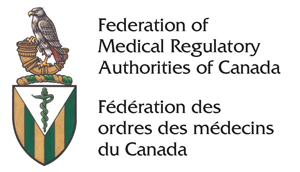The FMRAC Policy on Disclosure of Professional Information is in two parts:
Part A – Principles Applicable to Completing a Certificate of Professional Conduct
Part B – Content of a Certificate of Professional Conduct
Download the PDF document | Télécharger le document en PDF
There is a great degree of interrelatedness among these factors.
The following information will be contained in the Certificates of Professional Conduct (CPC) issued by the medical regulatory authorities of Canada:
1 – “Conditions” include any condition, term, restriction or limitation of any nature.
2 – “Settlement” means an agreement to resolve a lawsuit involving a patient either before or during court trial. A settlement may or may not include payment made on behalf of the registrant or former registrant to the patient or other parties in the lawsuit.
3 – “Finding” means any judgment or decision made against the registrant or former registrant by a court in relation to any lawsuit involving a patient. This includes, but is not limited to, a finding of negligence, malpractice or battery. It also includes findings in which the registrant or former registrant has been found by the court to be liable for the acts of others, including employees or agents, in a lawsuit involving a patient.
